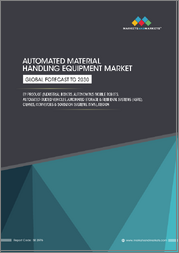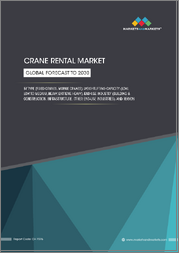
|
시장보고서
상품코드
1733762
세계의 크레인 시장 규모 : 유형별, 용도별, 지역별, 예측Global Crane Market Size By Type (Mobile Cranes, Fixed Cranes and Marine and Offshore Cranes), By Application (Construction, Mining and Excavation, Marine and Offshore), By Geographic Scope And Forecast |
||||||
크레인 시장 규모 및 예측
크레인 세계 시장 규모는 2024년에 22억 2,230만 달러로 평가되었고, 2026-2032년 4.00%의 연평균 복합 성장률(CAGR)로 성장하여 2032년에는 308억 9,000만 달러에 달할 것으로 예측됩니다.
세계 크레인에는 건설, 광업, 해양, 운송, 제조 및 기타 부문에서 자재를 들어 올리고, 이동하고, 위치를 지정하기 위해 설계된 다양한 중장비가 포함되어 있습니다.
크레인의 용도는 건물 건설용 타워 크레인, 현장의 다목적 이동용 이동식 크레인, 험한 지형에서 고부하 용량을 위한 크롤러 크레인 등 다양합니다.
향후 개발은 특히 신흥 경제국의 인프라 개발, 도시화, 산업 확장에 의해 촉진될 것으로 예측됩니다. 또한, 자동화, 텔레매틱스, 친환경 기술의 발전으로 작업 효율성과 지속가능성이 향상되어 여러 산업 분야에서 수요가 더욱 증가할 것으로 예측됩니다.
크레인 세계 시장 역학
세계 크레인 시장을 형성하는 주요 시장 역학은 다음과 같습니다.
주요 시장 성장 촉진요인
인프라 개발 및 도시화: 인프라 개발 및 도시화: 전 세계적으로 인프라 프로젝트에 대한 투자가 증가하고 있으며, 이는 크레인 수요를 견인하고 있습니다. 예를 들어, 미국 정부는 인프라 투자 및 일자리 촉진법(Infrastructure Investment and Jobs Act)을 통해 1조 2,000억 달러를 인프라 정비에 할당하고 있으며, 이로 인해 건설 활동이 활발해지고 이에 따라 크레인 사용량도 증가할 것으로 예측됩니다.
신흥 경제국의 건설 산업 성장 : 인도와 중국과 같은 국가에서는 급속한 도시화와 산업화로 인해 크레인 시장이 크게 성장하고 있습니다. 중국 국가 통계국에 따르면 건설 부문은 2022년 4.3% 성장할 것으로 예상되며, 인도 재무부는 인프라 지출이 9.1% 증가하여 대규모 프로젝트에 대한 크레인 수요를 뒷받침하고 있다고 보고했습니다.
자동화 및 텔레매틱스의 발전: 자동화 시스템 및 텔레매틱스 등 새로운 크레인 기술이 작업 효율성을 높이고 있습니다. 유럽연합(EU)의 Horizon 2020 이니셔티브는 산업 전반의 스마트 기술에 100억 유로 이상을 투자하여 산업 프로젝트에서 첨단 크레인 채택을 지원하고 있습니다.
지속 가능한 건설 관행: 환경 규제와 지속가능성에 대한 관심으로 인해 기업들은 전기 및 하이브리드 크레인과 같은 에너지 효율적인 크레인으로 전환하고 있습니다. 유럽 그린딜은 2030년까지 온실 가스 배출량을 55% 감축하는 것을 목표로 하고 있으며, 크레인을 포함한 친환경 건설 장비의 채택을 촉진하고 있습니다.
주요 과제
높은 초기 투자 비용: 크레인에는 많은 초기 투자가 필요하며, 이는 중소 건설사에게 장벽이 될 수 있습니다. 유지보수, 보험, 숙련된 운전자에 대한 비용과 더불어, 이러한 높은 비용은 특히 중소기업의 경우, 크레인 도입에 걸림돌이 될 수 있습니다.
엄격한 안전 및 환경 규제: 특히 유럽이나 북미와 같은 지역에서는 엄격한 안전 및 환경 기준을 준수하는 것이 운영 비용 증가와 프로젝트 지연으로 이어질 수 있습니다. 예를 들어, 유럽연합(EU)의 배기가스 기준은 중장비의 환경 영향을 줄이기 위해 비용이 많이 드는 업그레이드를 요구합니다.
공급망 혼란: 지정학적 긴장과 코로나19 사태로 인해 악화된 세계 공급망 문제는 철강, 반도체 등 주요 크레인 부품 수급에 영향을 미치고 있습니다. 그 결과, 크레인 제조업체의 프로젝트 지연과 제조 비용 상승을 초래하고 있습니다.
숙련된 작업자 부족: 크레인을 안전하고 효율적으로 운영하기 위해서는 전문 기술이 필요하며, 많은 지역에서 숙련된 작업자가 부족합니다. 이러한 부족은 인건비를 증가시키고 크레인에 의존하는 프로젝트의 운영 효율성을 떨어뜨릴 수 있습니다.
주요 동향
전기 크레인 및 하이브리드 크레인으로의 전환: 건설사들이 배출가스 감축을 위해 노력하는 가운데, 환경 유지가 전기 크레인 및 하이브리드 크레인에 대한 수요를 주도하고 있습니다. 전기 크레인은 저탄소 장비를 장려하는 규정으로 인해 유럽과 북미에서 인기를 끌고 있습니다.
텔레매틱스 및 IoT 통합 사용 증가: 크레인에 텔레매틱스 및 사물인터넷(IoT) 기능이 탑재되어 실시간 모니터링, 예지보전, 안전 강화가 가능해졌습니다. 이러한 추세는 특히 미국에서 두드러지게 나타나고 있으며, 각 기업들은 차량 관리를 개선하기 위해 디지털화에 투자하고 있습니다.
모듈형 건축과 조립식 건축의 부상: 모듈형 건축의 성장으로 인해 대형 조립식 부품을 취급할 수 있는 크레인에 대한 수요가 발생하고 있습니다. 모듈식 건축이 도시 지역에 확산됨에 따라, 이러한 요구에 부응하는 전용 크레인이 개발되어 효율을 높이고 건설 시간을 단축하고 있습니다.
자동화 및 원격 조작 능력: 자율 제어 크레인 및 원격 제어 크레인을 포함한 자동화 기술은 특히 위험하고 까다로운 환경에서 널리 보급되고 있습니다. 이러한 추세는 위험도가 높은 건설 및 광업 분야에서 작업 효율성과 작업자의 안전을 추구하는 데서 기인합니다.
목차
제1장 서론
- 시장의 정의
- 시장 세분화
- 조사 방법
제2장 주요 요약
- 주요 조사 결과
- 시장 개요
- 시장 하이라이트
제3장 시장 개요
- 시장 규모와 성장 가능성
- 시장 동향
- 시장 성장 촉진요인
- 시장 성장 억제요인
- 시장 기회
- Porter의 Five Forces 분석
제4장 크레인 시장 : 유형별
- 이동식 크레인
- 고정 크레인
- 해상/육상 크레인
제5장 크레인 시장 : 용도별
- 건설
- 채광 및 굴착
- 해상 및 육상
- 산업
제6장 지역별 분석
- 북미
- 미국
- 캐나다
- 멕시코
- 유럽
- 영국
- 독일
- 프랑스
- 이탈리아
- 아시아태평양
- 중국
- 일본
- 인도
- 호주
- 라틴아메리카
- 브라질
- 아르헨티나
- 칠레
- 중동 및 아프리카
- 남아프리카공화국
- 사우디아라비아
- 아랍에미리트(UAE)
제7장 시장 역학
- 시장 성장 촉진요인
- 시장 성장 억제요인
- 시장 기회
- COVID-19의 시장에 대한 영향
제8장 경쟁 구도
- 주요 기업
- 시장 점유율 분석
제9장 기업 개요
- Liebherr Group
- Terex Corporation
- Tadano Ltd.
- Manitowoc Company Inc.
- Zoomlion Heavy Industry Science & Technology Co.Ltd.
- XCMG Group
- Konecranes Plc
- Cargotec Corporation
- Sany Group Co.Ltd.
- Kobelco Construction Machinery Co.Ltd.
제10장 시장 전망과 기회
- 신기술
- 향후 시장 동향
- 투자 기회
제11장 시장 전망 부록
- 약어 리스트
- 공급원과 참고 문헌
Crane Market Size And Forecast
Global Crane Market size was valued at USD 22.23 Billion in 2024 and is projected to reach USD 30.89 Billion by 2032, growing at a CAGR of 4.00% from 2026 to 2032.
The global crane encompasses a variety of heavy machinery designed to lift, move, and position materials in sectors such as construction, mining, marine, transportation, and manufacturing.
Applications of cranes are extensive, including tower cranes for building construction, mobile cranes for versatile on-site movements, and crawler cranes for high-load capacities on challenging terrains.
Future growth is expected to be driven by increased infrastructure development, urbanization, and industrial expansion, particularly in emerging economies. Additionally, advancements in automation, telematics, and eco-friendly technologies are set to enhance operational efficiency and sustainability, further boosting demand across multiple industries.
Global Crane Market Dynamics
The key market dynamics that are shaping the global crane market include:
Key Market Drivers:
Infrastructure Development and Urbanization: Increasing investments in infrastructure projects globally drive crane demand. For instance, the U.S. government has allocated $1.2 trillion for infrastructure improvement through the Infrastructure Investment and Jobs Act, which is expected to spur construction activity and, consequently, crane usage.
Growing Construction Industry in Emerging Economies: Rapid urbanization and industrialization in countries like India and China are significantly boosting the crane market. According to the National Bureau of Statistics of China, the construction sector grew by 4.3% in 2022, while India's Ministry of Finance reported a 9.1% increase in infrastructure spending, supporting crane demand for large-scale projects.
Advancements in Automation and Telematics: New crane technologies, including automated systems and telematics, are enhancing operational efficiency. The European Union's Horizon 2020 initiative has invested over €10 billion in smart technologies across industries, aiding the adoption of advanced cranes in industrial projects.
Sustainable Construction Practices: Environmental regulations and a focus on sustainability are pushing companies toward energy-efficient cranes, such as electric and hybrid models. The European Green Deal aims to reduce greenhouse gas emissions by 55% by 2030, promoting the adoption of eco-friendly construction equipment, including cranes.
Key Challenges:
High Initial Investment Costs: Cranes require significant upfront investment, which can be a barrier for smaller construction firms. These high costs, along with expenses for maintenance, insurance, and skilled operators, can deter adoption, especially among small to mid-sized companies.
Stringent Safety and Environmental Regulations: Compliance with strict safety and environmental standards, particularly in regions like Europe and North America, can increase operational costs and lead to project delays. For example, the European Union's emissions standards necessitate costly upgrades to reduce the environmental impact of heavy machinery.
Supply Chain Disruptions: Global supply chain issues, exacerbated by geopolitical tensions and the COVID-19 pandemic, have impacted the availability of key crane components, such as steel and semiconductors. This has resulted in project delays and higher manufacturing costs for crane manufacturers.
Lack of Skilled Operators: Operating cranes safely and efficiently requires specialized skills, and there is a shortage of skilled crane operators in many regions. This shortage can increase labor costs and reduce the operational efficiency of crane-dependent projects.
Key Trends:
Shift to Electric and Hybrid Cranes: Environmental sustainability is driving demand for electric and hybrid cranes as construction companies work to reduce emissions. Electric cranes are gaining popularity in Europe and North America due to regulations promoting low-carbon equipment.
Increased Use of Telematics and IoT Integration: Cranes are increasingly equipped with telematics and Internet of Things (IoT) capabilities, allowing for real-time monitoring, predictive maintenance, and enhanced safety. This trend is particularly strong in the U.S., where companies are investing in digitalization to improve fleet management.
Rise of Modular and Prefabricated Construction: The growth of modular construction is creating demand for cranes capable of handling large, pre-fabricated components. As modular building becomes more popular in urban areas, specialized cranes are being developed to meet this need, boosting efficiency and reducing construction time.
Automation and Remote-Control Capabilities: Automation technologies, including autonomous and remote-controlled cranes, are becoming more prevalent, particularly in hazardous or challenging environments. This trend is driven by the push for operational efficiency and worker safety in high-risk construction and mining applications.
Global Crane Market Regional Analysis
Here is a more detailed regional analysis of the global crane market:
North America:
North America holds a dominant position in the global crane market due to the region's robust construction sector, advanced infrastructure projects, and high investment in renewable energy projects. The United States, in particular, contributes significantly, with the construction industry reaching a valuation of approximately $1.6 trillion in 2023, according to the U.S. Census Bureau. Major infrastructure investments, such as bridge repairs, highway expansions, and energy sector developments, drive the demand for high-capacity and specialized cranes.
The region's focus on modernization and automation in construction processes also plays a crucial role in crane market growth. The use of technologically advanced cranes with enhanced efficiency and safety features has risen, supporting the increased adoption of mobile, crawler, and tower cranes. Government initiatives, like the Infrastructure Investment and Jobs Act, further strengthen market prospects by allocating substantial funds toward public infrastructure and industrial projects.
Asia Pacific:
Asia Pacific is the fastest-growing region in the crane market, driven by rapid industrialization, urbanization, and massive infrastructure projects across countries like China, India, and Southeast Asia. China's "Belt and Road Initiative" and its 14th Five-Year Plan emphasize infrastructure development, with the government allocating approximately $1.8 trillion to infrastructure projects by 2025. This extensive investment fuels significant demand for cranes across various construction and logistics applications.
India's booming construction and manufacturing sectors further drive the crane market in the region. With a forecasted growth rate of over 8% in India's construction industry by 2025, cranes are in high demand to support large-scale projects such as the construction of new airports, railways, and smart cities. Government initiatives like "Make in India" are also promoting domestic manufacturing, increasing the need for material handling and industrial cranes to optimize production facilities.
Global Crane Market Segmentation Analysis
The Global Crane Market is segmented on the basis of By Type, By Application, and By Geography.
Global Crane Market, By Type
- Mobile Cranes
- Fixed Cranes
- Marine and Offshore Cranes
Based on Type, the Global Crane Market is segmented into Mobile Cranes, Fixed Cranes, Marine and Offshore Cranes. Mobile Cranes currently dominate due to their versatility and extensive use in various industries, including construction and infrastructure projects where mobility and flexibility are essential. These cranes are especially popular for their ability to handle different load capacities and move between sites with ease, giving them a competitive edge. However, the marine and offshore cranes segment is witnessing the fastest growth, driven by the increasing demand in offshore oil and gas exploration, as well as expanding maritime logistics and port development.
Global Crane Market, By Application
- Construction
- Mining and Excavation
- Marine and Offshore
Based on Application, the Global Crane Market is segmented into Construction, Mining and Excavation, Marine and Offshore. The Construction segment currently dominates due to high demand from ongoing infrastructure projects, urbanization, and industrial development worldwide. However, the Marine and Offshore segment is the fastest-growing, driven by expanding offshore oil and gas exploration, renewable energy projects, and increasing trade activities requiring specialized cranes to manage large marine cargo and offshore operations efficiently.
Global Crane Market, By Geography
- North America
- Europe
- Asia Pacific
- Rest of the World
Based on the Geography, the Global Crane Market are classified into North America, Europe, Asia Pacific, and Rest of World. North America holds a dominant position in the global crane market due to the region's robust construction sector, advanced infrastructure projects, and high investment in renewable energy projects. Asia Pacific is the fastest-growing region in the crane market, driven by rapid industrialization, urbanization, and massive infrastructure projects across countries like China, India, and Southeast Asia.
Key Players
The "Global Crane Market" study report will provide valuable insight with an emphasis on the global market. The major players in the market Liebherr Group, Terex Corporation, Tadano Ltd., Manitowoc Company, Inc. Zoomlion Heavy Industry Science & Technology Co., Ltd., XCMG Group, Konecranes Plc, Cargotec Corporation, Any Group Co., Ltd., Kobelco Construction Machinery Co., Ltd.
Our market analysis also entails a section solely dedicated to such major players wherein our analysts provide an insight into the financial statements of all the major players, along with its product benchmarking and SWOT analysis. The competitive landscape section also includes key development strategies, market share, and market ranking analysis of the above-mentioned players globally.
- Global Crane Market: Recent Developments
- In August 2024 Liebherr Group launched its latest mobile crane model, the LTM 1110-5.2, which incorporates fuel-efficient hybrid technology aimed at reducing emissions while maintaining high lifting capabilities. This development aligns with growing market demands for eco-friendly machinery, as regulations on emissions become stricter globally.
- In July 2024 Tadano Ltd. introduced its new GR-1300XL-4 rough terrain crane with enhanced lifting capacities and an advanced control system designed to optimize operational efficiency and safety. This crane is tailored for the North American market, where construction projects are rapidly expanding and demand for high-capacity, safe machinery is high.
- In June 2024 Konecranes announced a collaboration with a major European port to implement automated crane solutions designed to improve loading efficiency and reduce labor costs. This partnership reflects the trend toward automation in logistics and material handling, addressing the need for faster, more reliable port operations.
TABLE OF CONTENTS
1. Introduction
- Market Definition
- Market Segmentation
- Research Methodology
2. Executive Summary
- Key Findings
- Market Overview
- Market Highlights
3. Market Overview
- Market Size and Growth Potential
- Market Trends
- Market Drivers
- Market Restraints
- Market Opportunities
- Porter's Five Forces Analysis
4. Crane Market, By Type
- Mobile cranes
- Fixed cranes
- Marine and offshore cranes
5. Crane Market, By Application
- Construction
- Mining and excavation
- Marine and offshore
- Industrial applications
6. Regional Analysis
- North America
- United States
- Canada
- Mexico
- Europe
- United Kingdom
- Germany
- France
- Italy
- Asia-Pacific
- China
- Japan
- India
- Australia
- Latin America
- Brazil
- Argentina
- Chile
- Middle East and Africa
- South Africa
- Saudi Arabia
- UAE
7. Market Dynamics
- Market Drivers
- Market Restraints
- Market Opportunities
- Impact of COVID-19 on the Market
8. Competitive Landscape
- Key Players
- Market Share Analysis
9. Company Profiles
- Liebherr Group
- Terex Corporation
- Tadano Ltd.
- Manitowoc Company Inc.
- Zoomlion Heavy Industry Science & Technology Co.Ltd.
- XCMG Group
- Konecranes Plc
- Cargotec Corporation
- Sany Group Co.Ltd.
- Kobelco Construction Machinery Co.Ltd.
10. Market Outlook and Opportunities
- Emerging Technologies
- Future Market Trends
- Investment Opportunities
11. Appendix
- List of Abbreviations
- Sources and References



















